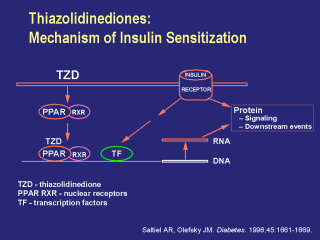| front |1 |2 |3 |4 |5 |6 |7 |8 |9 |10 |11 |12 |13 |14 |15 |16 |17 |18 |19 |20 |21 |22 |23 |24 |25 |26 |27 |28 |29 |30 |31 |32 |33 |34 |35 |36 |37 |38 |39 |40 |41 |42 |43 |44 |45 |46 |47 |48 |49 |review |
 |
Thiazolidinediones cross the plasma membrane
and pass through the cytoplasm to the nucleus, where they bind with
peroxisome proliferator-activated receptors, which are in conformation with
retinoic X receptors. This activated complex integrates with the ribosomal
moieties. Once insulin binds to its receptor, it has immediate postreceptor actions; but of importance, it also sends a transnuclear signal into the nucleus to activate transcription factors in the ribosomal matrix. The activated thiazolidinedione–peroxisome proliferator-activated receptor/retinoic X receptor complex augments the function and efficiency of the transcription factor process that insulin has initiated. This augmentation increases the nuclear-based actions of insulin, which include the signal for formation of proteins involved in enzymatic processes, cell growth, regulation of insulin receptor activity, and glucose transport into the cell itself. Saltiel AR, Olefsky JM. Diabetes. 1996;45:1661-1669. |